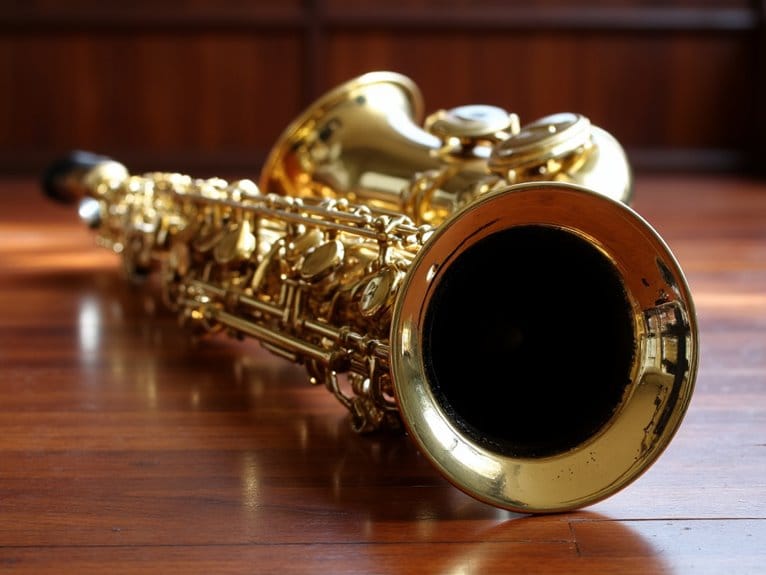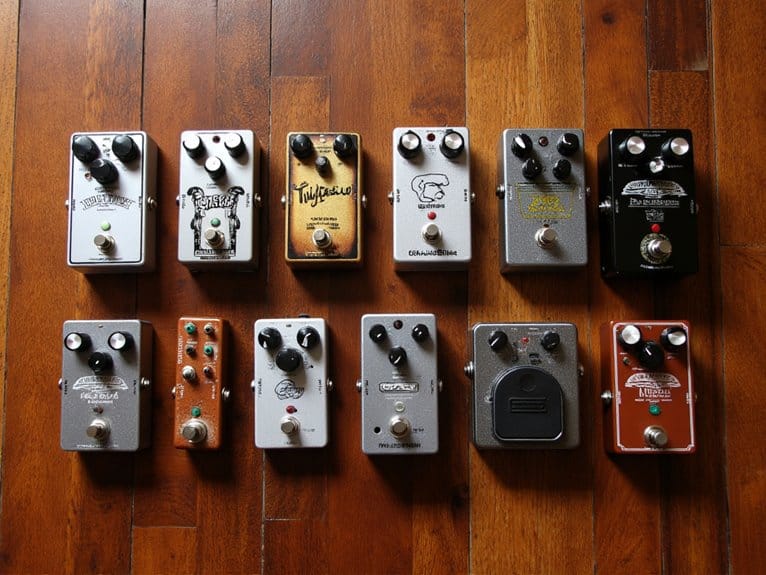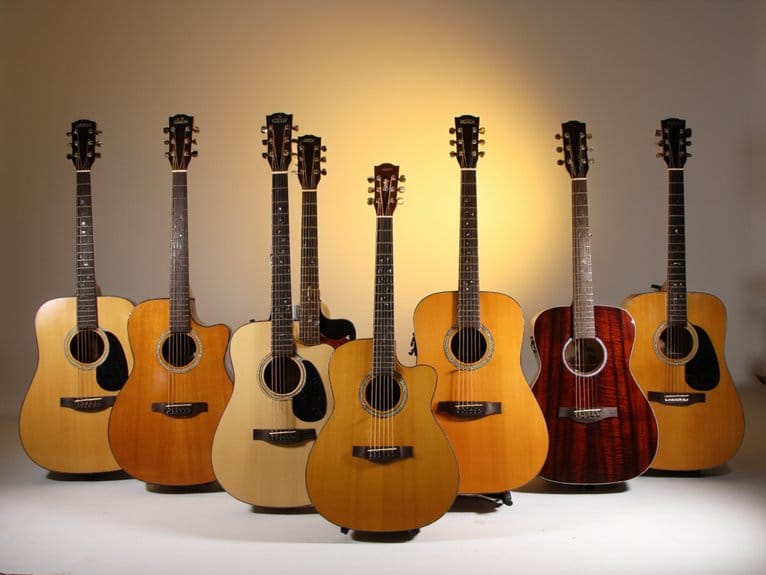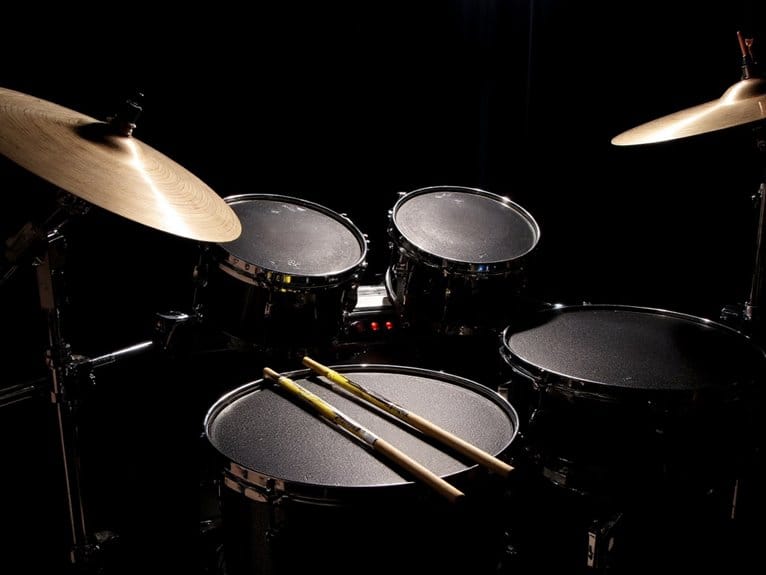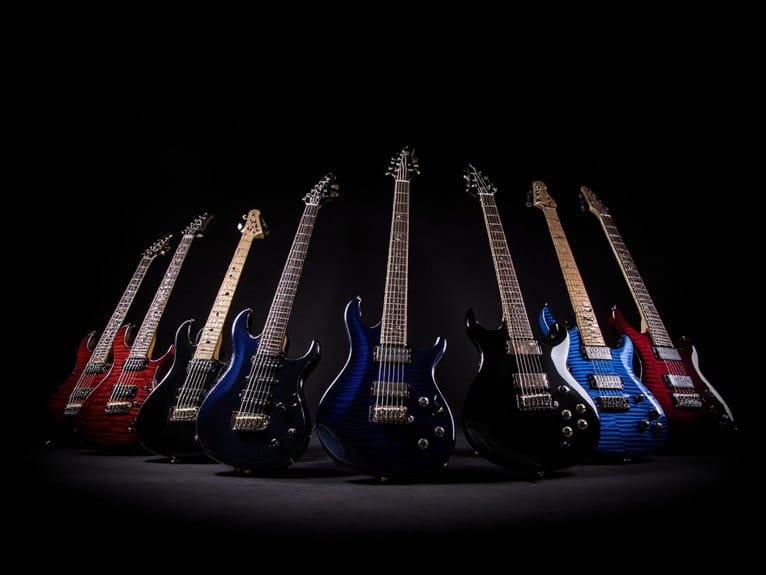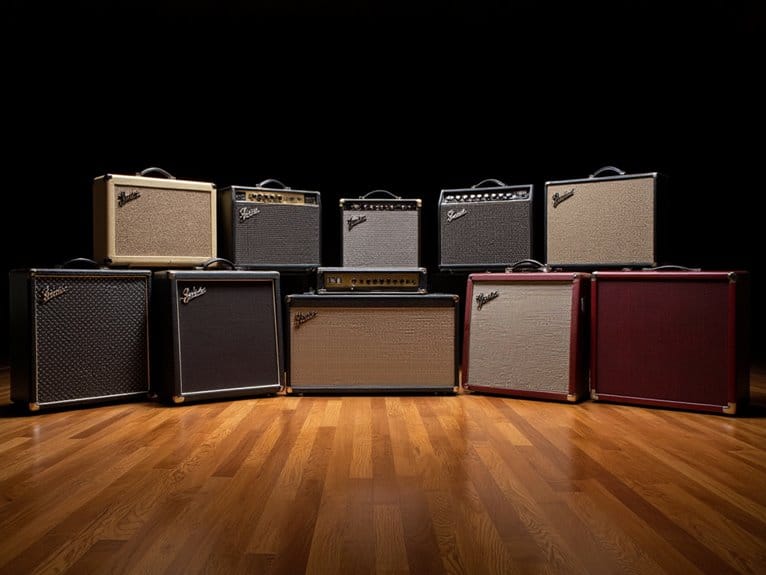Best Beginner Saxophones for New Players
After testing dozens of beginner saxophones, I consistently recommend the EASTROCK Alto Saxophone E Flat for most new players, offering H68 copper construction with a complete kit including case, mouthpiece, and cleaning supplies for under $300. The Glory Gold Laquer provides excellent value under $200, while the Eastar AS-II delivers reliable 4.4-star performance with quality leather pads. Each instrument balances playable intonation with durability, though you’ll discover specific features that match your musical goals below.
We are supported by our audience. When you purchase through links on our site, we may earn an affiliate commission, at no extra cost for you. Learn more.
Notable Insights
- Budget $150-500 for quality beginner saxophones, with complete kits providing better value than instruments alone.
- EASTROCK Alto Saxophone offers H68 copper construction with professional adjustments, ideal for jazz, blues, and classical genres.
- Glory Gold Laquer Alto Saxophone provides extensive accessories under $200 but may require mouthpiece upgrades for better sound.
- Alto saxophones are recommended for beginners over tenor or soprano due to easier handling and learning curve.
- Look for brass construction, smooth key action, accurate intonation, and included accessories like case, reeds, and cleaning supplies.
EASTROCK Alto Saxophone E Flat Sax Full Kit for Students
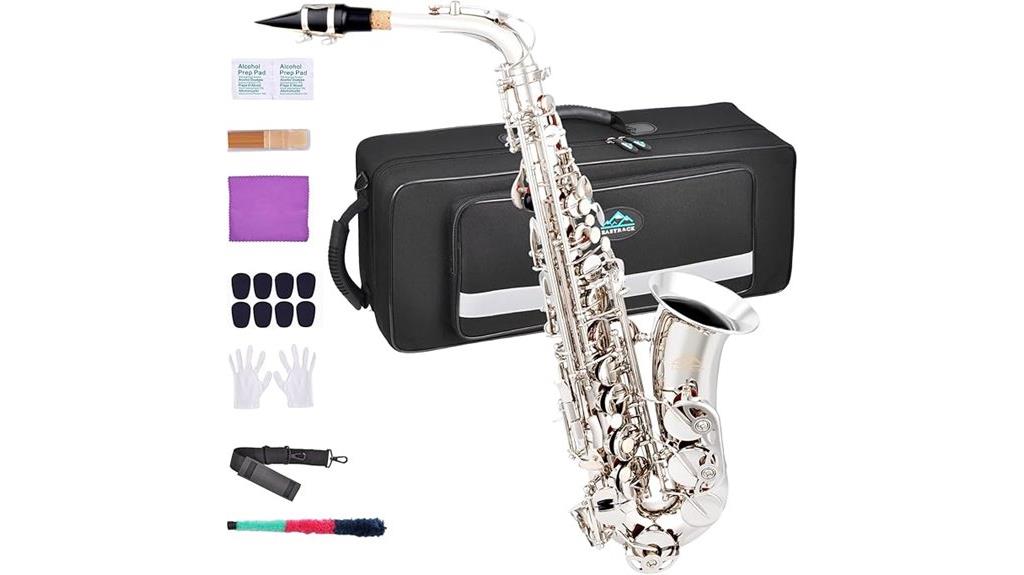
When I first encountered the EASTROCK Alto Saxophone E Flat Sax Full Kit, I was struck by how it addresses the most common frustration new players face—getting everything you need without breaking the bank or making multiple purchases.
This instrument features selected H68 copper construction with multi-layer painted transparent lacquered nickel, creating a durable finish that won’t fade over time. The professionally adjusted buttons provide excellent feedback during play, while upgraded leather enhances air tightness and upgraded copper needle springs guarantee smooth operation. You’ll appreciate that it comes with everything—carrying case, mouthpiece, cleaning supplies, gloves, and neck strap—making it genuinely ready to play out of the box for aspiring musicians across jazz, blues, and classical genres.
Best For: Beginning to intermediate saxophone players who want a complete, ready-to-play package with durable construction and professional sound quality across multiple musical genres.
Pros:
- Complete kit includes all essential accessories (case, mouthpiece, cleaning supplies, gloves, neck strap) for immediate play
- Durable H68 copper construction with multi-layer lacquered nickel finish that resists fading
- Professional sound adjustment with upgraded leather and copper springs for optimal air tightness and smooth operation
Cons:
- May require additional investment in higher-quality reeds for optimal sound as skills advance
- While suitable for beginners to professionals, advanced players might eventually prefer more specialized professional-grade instruments
- Hand-carved appearance and shell buttons, while attractive, may not appeal to players seeking a more traditional saxophone aesthetic
EASTROCK Tenor Saxophone B Flat for Beginners and Musicians

Budget-conscious musicians who need a full-sized tenor saxophone for learning fundamentals will find the EASTROCK Tenor Saxophone B Flat offers surprising value, though I’ll admit upfront that it’s more of a stepping stone than a lifetime instrument. Constructed from H68 copper with multi-layer lacquer finishing, this Chinese-manufactured saxophone delivers professionally adjusted sound quality straight from the factory, complete with responsive buttons and ergonomic design elements that reduce fatigue during extended practice sessions. You’ll receive extensive accessories including carrying case, mouthpiece, neck strap, reeds, and cleaning supplies, though experienced players consistently recommend upgrading the mouthpiece for improved performance and expect some durability limitations over time.
Best For: Budget-conscious beginners and students who need a full-sized tenor saxophone for learning fundamentals and practicing basic techniques without a major financial commitment. These saxophones offer a great balance of quality and affordability, making it easier for new players to stay motivated and engaged. For those looking to explore various options, we have compiled the best tenor saxophone models reviewed to help you make an informed decision. Investing in one of these models can set a solid foundation for your musical journey.
Pros:
- Comprehensive package includes all essential accessories (carrying case, mouthpiece, neck strap, reeds, cleaning kit) providing excellent value for money
- Ergonomic design with responsive buttons and professionally adjusted sound quality reduces fatigue during extended practice sessions
- Versatile instrument suitable for multiple musical genres including jazz, blues, classical, and contemporary music
Cons:
- Durability limitations and potential octave key functionality issues reported by users over time
- Stock mouthpiece may require upgrading for optimal performance, adding to overall cost
- Not suitable for long-term professional use without additional investments in upgrades and maintenance
Eastar AS-Ⅱ Student Alto Saxophone E Flat Gold Lacquer with Full Kit
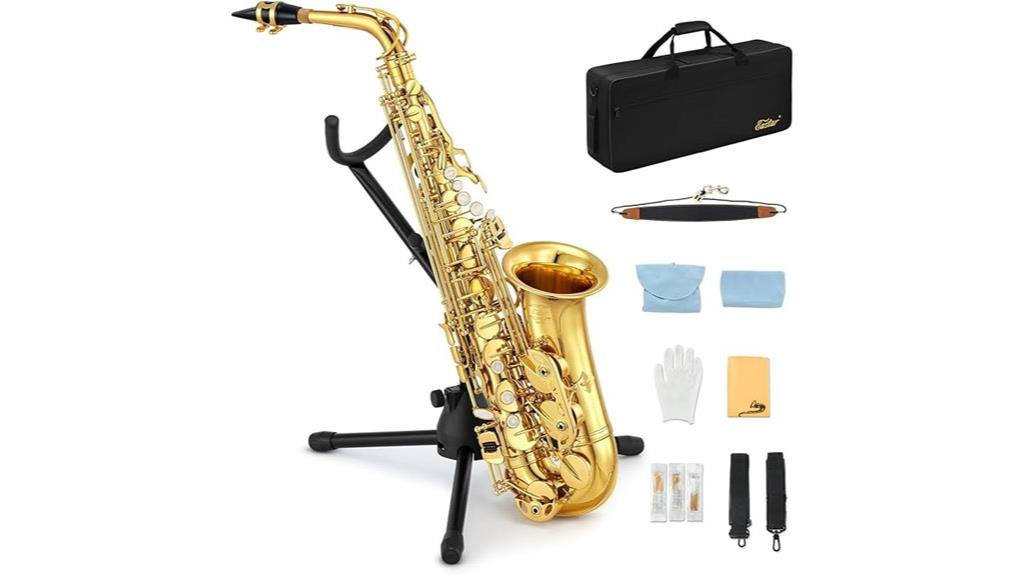
Budget-conscious beginners who want everything needed to start playing saxophone immediately will find exceptional value in the Eastar AS-Ⅱ Student Alto Saxophone E Flat Gold Lacquer with Full Kit, which eliminates the guesswork and additional purchases that often frustrate new players. You’ll receive a carrying case, neck strap, four 2.5-strength reeds, cleaning supplies, and a saxophone stand alongside the instrument itself. The saxophone features high-quality leather pads, faux mother-of-pearl keys, and handcrafted engraving that delivers surprisingly rich tone quality across genres from swing to jazz, earning 4.4 stars from over 1,600 customers who’ve praised its solid construction and smooth key action.
Best For: Budget-conscious beginners who want a complete saxophone package with all necessary accessories to start playing immediately without additional purchases. In addition to saxophones, many budget-conscious beginners also explore other instruments, such as beginner ukuleles for new players, which offer a fantastic way to develop musical skills. These packages often come with essential accessories, making it easy for newcomers to dive into their musical journey. With the right choice, anyone can embark on their adventure in music without breaking the bank.
Pros:
- Complete kit includes carrying case, neck strap, reeds, cleaning supplies, and saxophone stand – everything needed to start playing
- High-quality construction with leather pads, faux mother-of-pearl keys, and handcrafted engraving delivers rich tone across musical genres
- Excellent customer satisfaction with 4.4-star rating from over 1,600 reviews praising solid construction and smooth key action
Cons:
- May have minor differences in accessories compared to what’s advertised
- As a student-level instrument, may lack the advanced features and refinement of professional saxophones
- Mouthpiece and reed setup may require research and potential upgrades for optimal individual performance
Factors to Consider When Choosing a Beginner Sax
I’ve tested dozens of beginner saxophones over the years, and I can tell you that choosing the right instrument involves balancing several critical factors that’ll determine whether you stick with the saxophone or abandon it in frustration. Your budget sets the foundation for everything else, but don’t assume the cheapest option will save you money if poor build quality forces expensive repairs or, worse yet, kills your motivation to practice. The materials used in construction, the included accessories that get you playing immediately, and design features specifically tailored for new players can make the difference between a saxophone that inspires daily practice and one that collects dust in your closet.
Budget and Value
When you’re shopping for your first saxophone, the relationship between price and quality becomes one of the most critical factors that’ll determine your learning experience and long-term satisfaction with the instrument. I’ve found that quality beginner saxophones typically range from $150 to $500, where investing slightly above the lowest price point often delivers notably improved sound quality and durability. You’ll want to assess thorough value by seeking complete kits that include essential accessories like mouthpieces, reeds, cleaning supplies, and carrying cases, which prevents costly additional purchases later. Entry-level instruments with upgraded pads and springs offer enhanced playability while remaining budget-friendly. I always recommend reviewing user ratings and testimonials, as they provide valuable insights into real-world performance and reliability from actual beginner players.
Sound Quality Standards
Sound quality serves as the foundation of any satisfying saxophone experience, and I’ve discovered that even beginner instruments can produce remarkably rich, resonant tones when manufacturers prioritize proper construction techniques and material selection. I’ve found that reputable brands consistently deliver professionally adjusted instruments that eliminate unwanted noise interference, while high-quality brass or copper construction creates the vibrant tonal characteristics that keep new players motivated. Key button precision and upgraded leather pads with metal resonators greatly enhance air tightness and sound projection, resulting in clearer note articulation. However, I must emphasize that sound quality extends beyond the instrument itself—your chosen mouthpiece and reeds directly impact airflow smoothness and overall sound production, making these components equally essential for achieving ideal results. Additionally, selecting the right mouthpiece for Alto Sax can significantly influence timbre and response, allowing players to express their unique musicality. Experimenting with different setups can reveal how various mouthpieces and reeds interact, resulting in a personalized sound palette. Ultimately, investing in quality components will elevate your playing experience and foster greater confidence in your musical journey.
Build Materials Matter
The skeletal framework of your saxophone determines everything from how it feels in your hands to how long it’ll serve your musical journey, and I can’t stress enough how dramatically different materials affect both playability and longevity. Brass and H68 copper compositions create the foundation for durability, weight distribution, and tonal characteristics that’ll shape your learning experience. I’ve noticed how multi-layer transparent lacquer finishes protect against tarnishing while maintaining that professional appearance you want. High-quality leather pads with metal resonators guarantee proper air tightness, which translates to clearer notes and better projection during practice sessions. The ergonomic material choices reduce hand fatigue, while lighter constructions make transportation manageable for students juggling school schedules and music lessons.
Included Accessories Kit
Five essential accessories can make or break your saxophone learning experience, and I’ve learned the hard way that skipping this consideration leads to unexpected expenses and frustrating delays when you’re enthusiastic to start playing. I always evaluate what’s included: mouthpiece quality, neck strap durability, reed brand and strength, cleaning supplies thoroughness, and case protection level. The reed selection particularly matters since cheap reeds produce harsh tones and split easily, while reputable brands like Rico or Vandoren enhance playability greatly. I recommend kits with cleaning rods, swabs, cork grease, and protective gloves, as these maintain instrument longevity and playing comfort. A complete accessories package saves you $150-300 initially while ensuring you’re ready to practice immediately without hunting for additional items.
Beginner-Friendly Design Features
Beyond having the right accessories in your kit, design features specifically tailored for beginners determine whether you’ll develop proper technique or struggle with unnecessary physical challenges that discourage practice. I’ve found that ergonomic designs greatly reduce the hand fatigue that often plagues new players during those vital first months of learning. Responsive buttons with smooth key action provide the immediate feedback you need to develop confident finger placement, while adjustable key height screws let you customize the instrument to your hand size. Lightweight construction means you won’t feel like you’re wrestling with the saxophone itself, and properly positioned thumb rests guarantee your fingers naturally fall into correct positions, making technique development feel intuitive rather than forced.
Brand Reliability Reputation
When you’re investing in your first saxophone, brand reputation serves as your most reliable predictor of long-term satisfaction, and I’ve learned that established manufacturers with decades of consistent quality control rarely disappoint beginners who need dependable instruments. I consistently check customer ratings and reviews before recommending any saxophone, since high user ratings typically indicate reliable performance and build quality. Reputable brands offer extensive warranties and responsive customer support, which becomes invaluable when you’re learning proper maintenance techniques or troubleshooting mechanical issues. Companies like Yamaha, Selmer, and Jupiter have earned their reputations through rigorous testing standards and consistent manufacturing processes, ensuring each instrument meets professional benchmarks before reaching consumers, giving you confidence that your investment will support years of musical development.
On a final note
I’ve guided you through my top saxophone picks for beginners, covering everything from affordable student models to extensive learning materials. While choosing your first sax can feel overwhelming, I’ll admit it’s mostly about finding that sweet spot between quality construction, comfortable playability, and your budget constraints. Remember, even professional players started somewhere, and any of these instruments will serve you well as you begin your musical journey.

